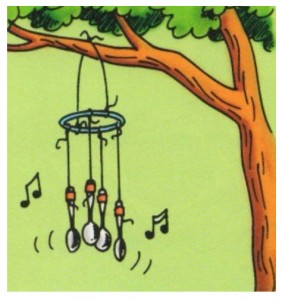What is Sound? How is Sound Produced?
Sound is a form of energy, just like electricity and light. Sound is produced when something, like a guitar string vibrates (moves back and forth) when strummed. With each back and forth motion of the string, the air around the string is pushed outward on one side and the air moves inward on the opposite side.
 The back and forth motion of the string causes the air molecules to move in a pattern called waves, or sound waves (sound energy). Sound waves are produced, but not all of them are heard. You “hear” sound when sound wave enter your ear which sends a message to your brain where it is decoded as a specific “sound.”
The back and forth motion of the string causes the air molecules to move in a pattern called waves, or sound waves (sound energy). Sound waves are produced, but not all of them are heard. You “hear” sound when sound wave enter your ear which sends a message to your brain where it is decoded as a specific “sound.”
Wind chimes are made of objects, such as metal spoons, that produce sound waves when when the object bump into each other.
Discover for Yourself
Make your own wind chimes by following these steps.
1. Tie one 12-in (30-cm) piece of piece to each of 4 or more metal spoons.
2. Tie the free end of the strings to a metal jar ring or small embroidery hoop. The spoons should hang so that they can easily bump into each other.
3. Tie a string on opposite sides of the ring to hang the chimes with.
4. Before hanging the chimes outdoors, test them by blowing on the spoons. Reposition the spoons and/or add more spoons if the musical sounds are not what you want.
5. Hang the spoon chimes outdoors.
Science Project Ideas
1. What effect does the type of vibrating material have on the sound of wind chimes?
Clues: Change only the type of material. Keep other variables, such as shape and size the same. Replace the metal spoons with plastic spoons or spoons made of a different kind of metal (silver spoon vs. stainless steel spoons, etc…).
2. What effect does the size of vibrating material have on the sound of wind chimes?
Clues: Change only the size of the spoons. If you start with small spoons, you can replace the original spoons with tablespoons and/or tea spoons. The spoons need to be made of the same metal and have the same basic shape. Thus, use spoons that come from a set of flatware.
3. What effect would different objects have on the sound of the wind chimes?
Clues: First, for your controls, create wind chimes using each type of object. For example, Control #1 four metal spoon; Control #2 Four metal nails; Control #3 Four plastic spoons; Control #4 Four metal tubes.
Second: Create a wind chime using one of each of the materials used to create the controls.
Third: Hang the five chimes, and shake one of the controls. Observe its sound. Then shake the experimental test chimes. Compare the sounds of each.
Repeat this for each control.
A video recording of each wind chime is a great way of collecting data. You can then watch the video several times to make more accurate comparisons.
4. What effect would hanging the objects at different lengths have on the sound of the wind chimes?
Clues: Make sure you use the same kind of string for each Control and the testing wind chime.
3. In the following video, musical instruments are made from different vegetables, including carrots and potatoes. You could create musical instruments for a science project.
